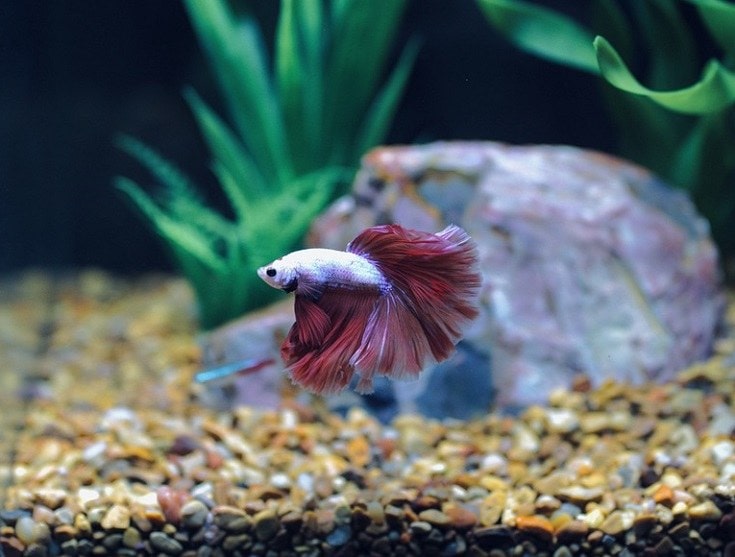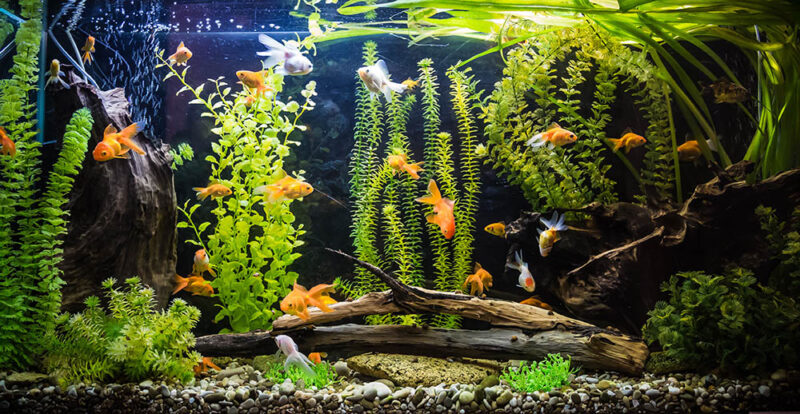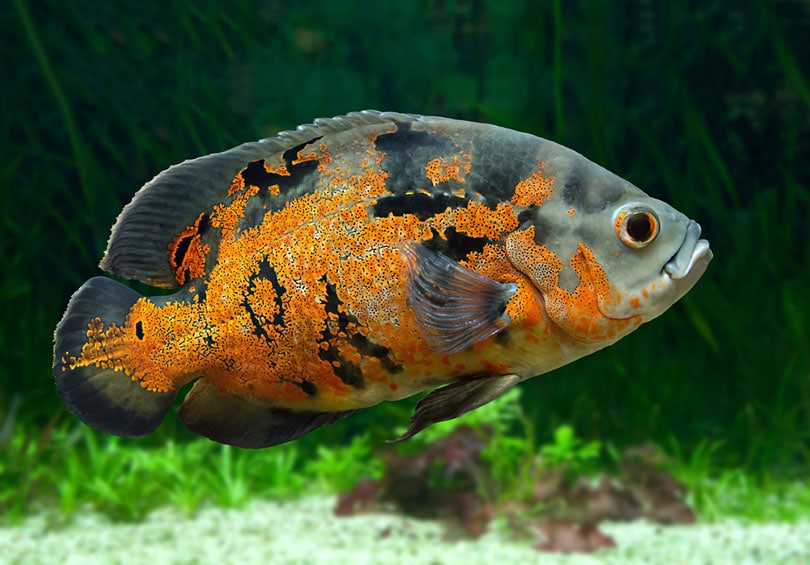
Click to Skip Ahead
If you’ve spotted an Oscar in the local pet store, you’ve probably found the fish to be unassuming, and maybe even boring. What you probably didn’t know is that the Oscar is one of the top fish you should pick if you’re interested in a fish that starts off small and turns into an absolute monster. Of course, oversized fish aren’t for the average home aquarium, so here’s what you should know about the mighty Oscar.
Breed Overview
| Size: | 10 – 14 inches |
| Lifespan: | 10 – 20 years |
| Similar Breeds: | Other Cichlids |
| Suitable for: | Experienced fish owners, large tanks |
| Temperament: | Territorial, intelligent |
It’s not uncommon for an unsuspecting person to take home an Oscar only to realize just how big and messy they can be a few years down the road. These large fish aren’t for the average fishkeeper, but they can be excellent aquatic pets for the right owners. If you’re familiar with Oscars, then you’re likely used to seeing dark-colored fish. However, there are now multiple varieties of Oscars because of selective breeding, so you have lots of interesting colors and patterns to choose from.
Oscar Breed Characteristics
 Oscar Fish Cost
Oscar Fish Cost
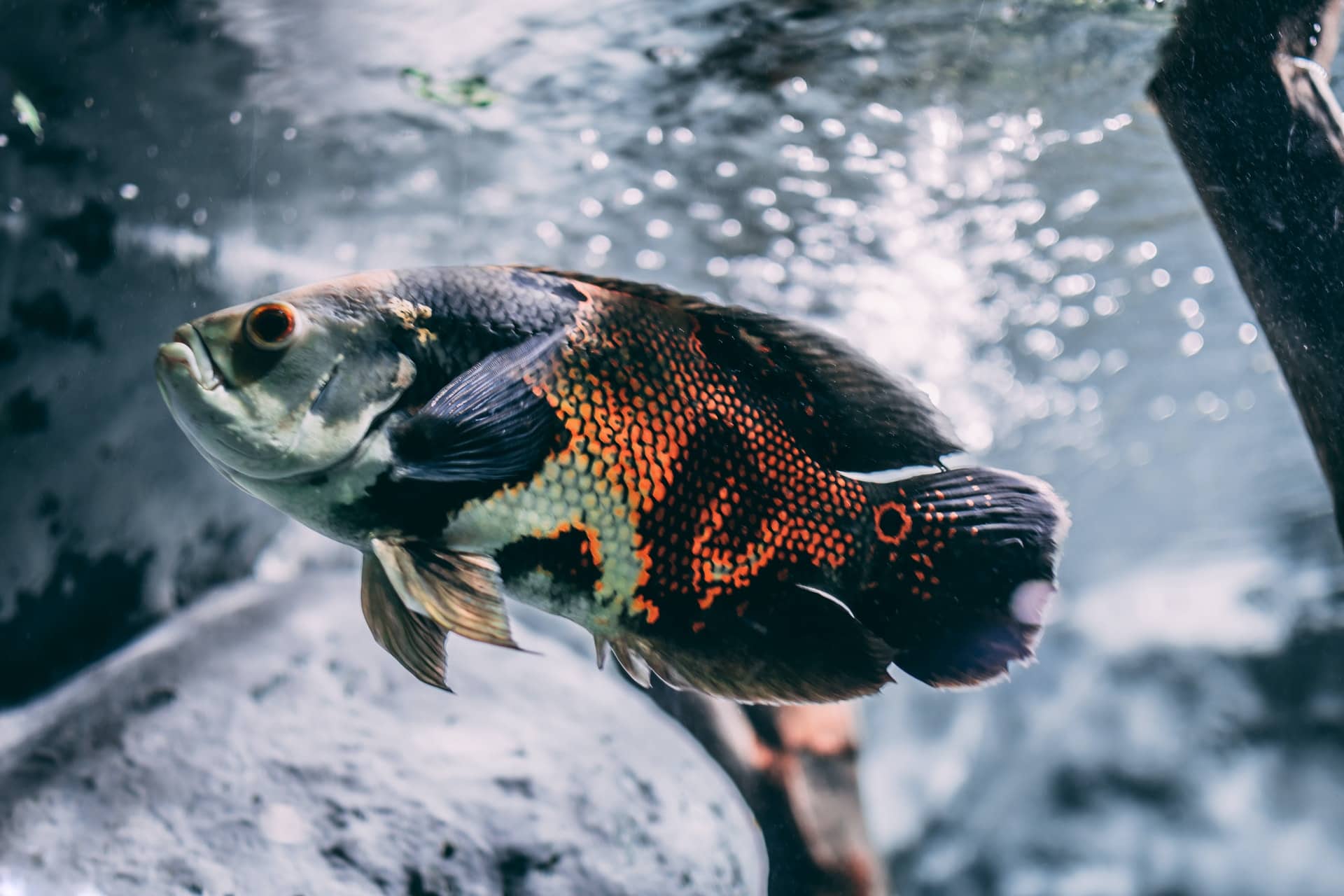
The average Oscar is available in most pet and aquatics shops, so they’re generally easy to find. Small juveniles are often available for as little as $5–$15, while adults are likely to continue to go up in cost as they become larger. Specialty varieties of Oscars usually sell for more than the normal varieties.
Although albino Oscars aren’t new, they do tend to sell for more due to their desirable coloration.
If you’re in the market for a specialty Oscar, you should expect to spend at least $20 on a small fish. It’s much more likely that you’ll spend $40–$50 on a juvenile Oscar that has desirable traits, though. It’s not uncommon for specialty varieties to exceed $100, depending on fish quality, colors, and size.
Sociability of Oscars
Do These Fish Make Good Pets?
Oscars are intelligent fish that may interact with their owners through the glass, especially at mealtimes. They are curious fish that can be interesting to watch, and once they begin to get large, they create an eye-catching, imposing presence in the tank. They are not suitable for beginning fish keepers, though. They do best with experienced fish keepers and a large, heavily filtered environment.
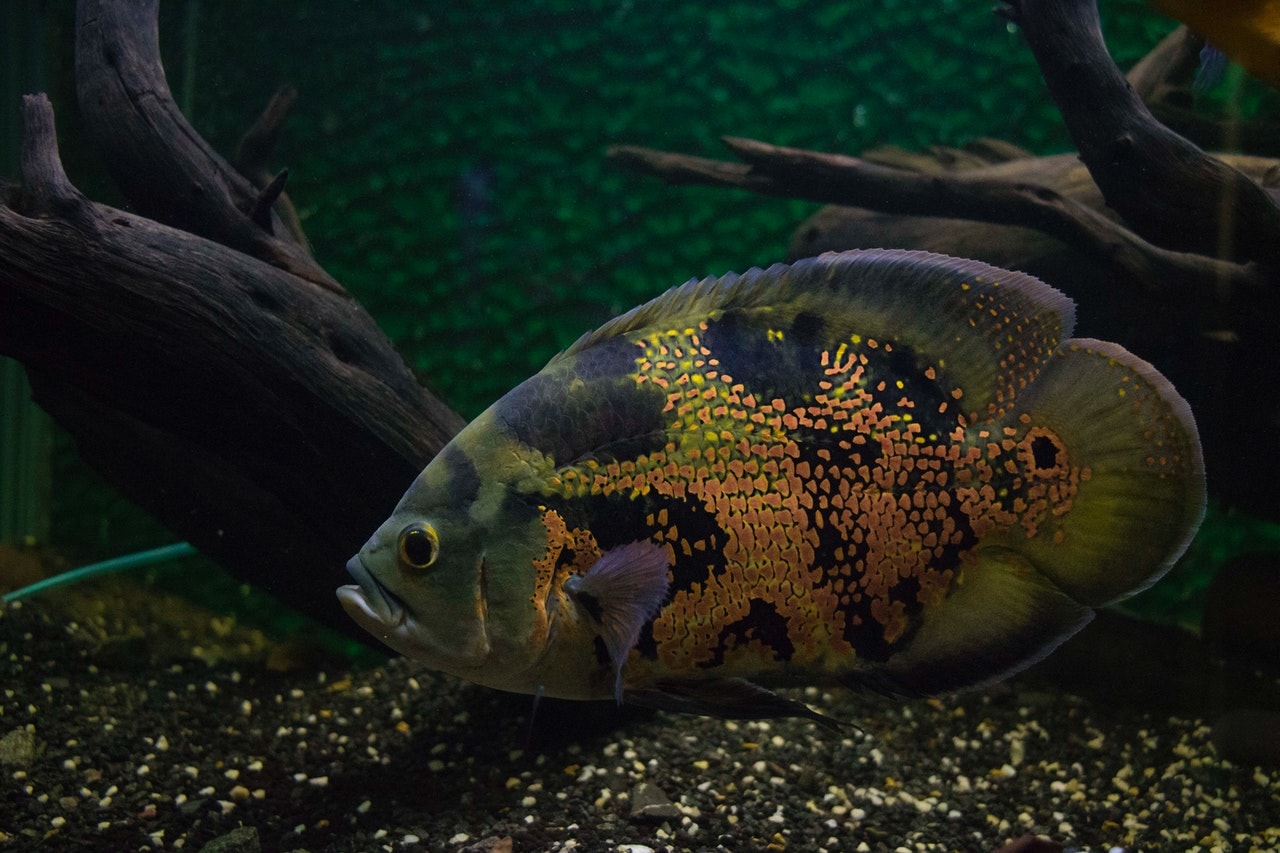
Does This Fish Make a Good Tankmate?
No, the Oscar is a territorial fish that can be a pretty lousy tankmate to other fish. Many people keep their Oscars in pairs, and a bonded pair of Oscars, usually a male and female, tend to do well together. Small tankmates are at risk of becoming lunch, while other large tankmates may threaten your Oscar’s territory. They are technically solitary fish, so a partner and other tankmates aren’t necessary for the happiness of your Oscar.
Care Guide & Tank Set Up
Water Quality, pH & Temperature
Although they are considered generally healthy fish, the Oscar can be quite sensitive to poor water quality. They are also susceptible to infections that can occur when water quality is low. Their tank should have no ammonia or nitrites, while nitrate levels should be kept around 20 ppm or less.
They are tropical fish that prefer water temperatures around 75–80°F. Unlike some Cichlids that prefer very alkaline water, the Oscar prefers neutral water around 7.0 pH. They can tolerate water pH between 6.0 and 8.0, though.
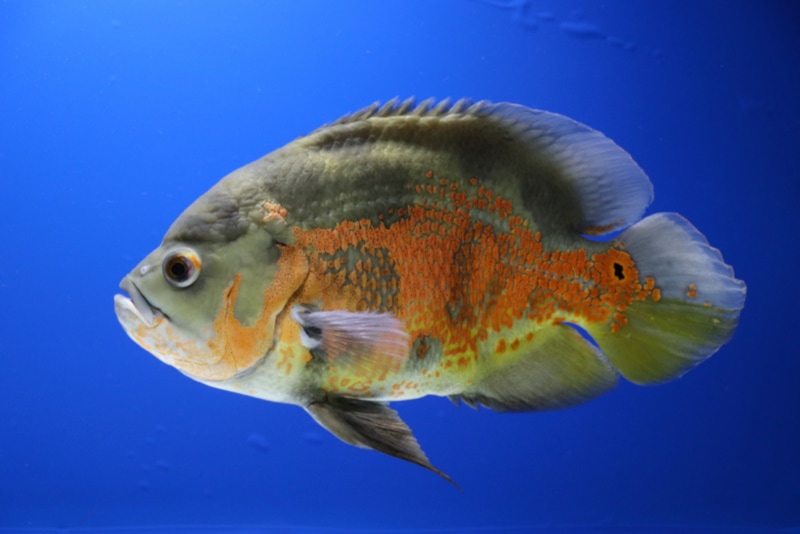
Substrate
Oscars are diggers, so they need a substrate that is safe for them to do so. Sand and gravel are suitable substrates, with sand being more preferable. Avoid anything with sharp edges or things that are large enough to become wedged in the mouth. You’ll likely spot your Oscar picking up mouthfuls of the substrate and spitting it back out.
Plants
It can be extremely difficult to keep plants in an Oscar tank. They love to dig and rearrange their environment, so plants are often uprooted or torn up. You can try to provide live plants that can be attached securely to surfaces, like Java ferns, and you can try floating plants. Sometimes, floating plants are either not of interest to an Oscar or they are too large to fit into their mouth.
Lighting
Oscars don’t have specific lighting needs outside of a normal day/night lighting cycle. If you do choose to keep live plants in your Oscar tank, then you’ll need lighting that can support plant life.
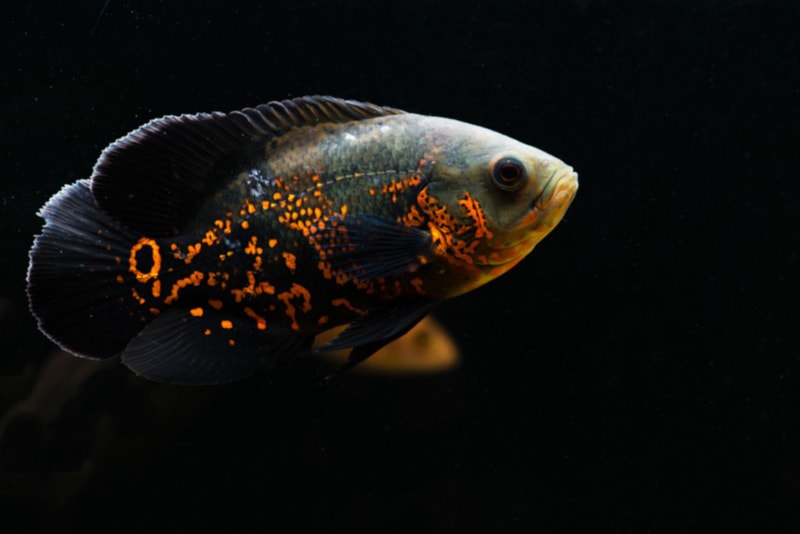
Filtration
Oscars are notoriously messy fish. They create a very heavy bioload in their tank, even when still small, and they require strong filtration to maintain their water quality. You should be prepared to do regular water changes, as well as to provide filtration that is rated for at least the size of your tank. With heavy bioloads, it’s often a good idea to choose a filter that is rated for a tank that is larger than your current tank. You can underfilter your tank, but you aren’t going to over-filter your Oscar’s tank.
Things to Know When Owning an Oscar:
Food & Diet Requirements
Oscars are omnivorous, but they tend to eat more meaty foods than fruits and veggies. In the wild, they are often seen eating crustaceans, fish, and insect larvae. In captivity, they can be fed a variety of foods, but it’s recommended to use a high-quality carnivore or Cichlid pellet as the base of their diet. Bloodworms, shrimp, brine shrimp, tuna, mussels, and other meaty treats can be offered. They may eat fruit or vegetables that are offered to them, and there is a possibility of your Oscar eating some of the tastier plants in their tank.

Size & Growth Rate
When you bring home a juvenile Oscar, it will likely only be a couple of inches long. They are extremely fast growers, though, usually gaining around 1 inch per month until they reach their full adult size. At this rate, an Oscar is usually close to being fully grown by around 1 year of age.
Keeping your Oscar in a tank that is too small may stunt their growth, but this is due to poor effects on their health and isn’t recommended. In captivity, Oscars usually reach 10 to 12 inches but can reach up to 14 inches in some situations.
Varieties
Lifespan and Health Conditions
It might surprise you to learn that these fish have an excellent lifespan, living anywhere from 10–20 years. However, there are some health concerns you’ll need to look out for.
Male vs Female
Oscars are monomorphic fish, so the males and females look essentially identical. Once they reach about 5 months of age, you may be able to sex your Oscars. If you look at their anal area, you’ll spot two openings. One is the anus, which releases waste. The second is the reproductive organs. In males, you’ll spot a pointed area, while females will have a wider and blunter organ.
 3 Little-Known Facts About Oscar Fish
3 Little-Known Facts About Oscar Fish
1. They Can Become Invasive
Oscars are native to the Amazon region of South America, so they love tropical environments. Unfortunately, the state of Florida is the perfect environment to support their growth and reproduction. Due to irresponsible fish keepers releasing unwanted Oscars, they have become invasive in Florida, and due to their size and aggression, they often outcompete native species for resources.
2. Their Juvenile Size Is Deceptive
If you spot an Oscar of any variety in a store, then you’ll likely see a fish that is 4 inches in length or less. Between their deceptively small size and many stores not properly educating people on the long-term needs of fish they take home; Oscars often end up outgrowing their environment quickly. They are commonly rehomed, sold to aquatic shops, or illegally released.
3. They Are Cichlids
This has already been referenced, but the fact that Oscars are a type of Cichlid often comes as a surprise to many people. Cichlids often sport the word “Cichlid” in their name, while the Oscar does not. Because of this, some people overlook that they have similar needs to other South American Cichlids.

Final Thoughts
A full-grown Oscar is a sight to behold, regardless of the variety. They reach very large sizes, sometimes exceeding 14 inches in length, and they grow extremely quickly. The Oscar is most suitable for a home with an experienced fish keeper and a large aquarium with plenty of space. Tankmates should be selected carefully due to the aggression and territorial nature of this fish. You can expect an intelligent fish that interacts with you if you bring home an Oscar, though!
Also Read:
- Hatchetfish: Care Guide, Pictures, Tank Setup & Info
- Silver Dollar Fish: Care Guide, Pictures, Tank Setup & Info
Featured Image Credit: Ekaterina V. Borisova, Shutterstock
 Oscar Fish Cost
Oscar Fish Cost
